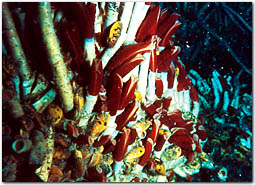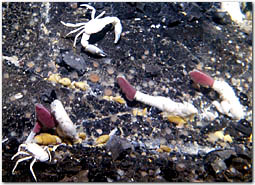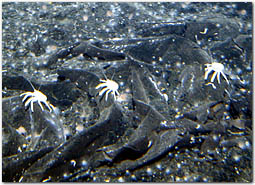
|
Click here for a high-resolution seafloor map of Rosebud and Rose Garden.
|

|
 |
Science Highlights > Rosebud Succeeds Rose Garden
Rosebud Succeeds Rose Garden
 |

Click to enlarge
|
|
The “Rose Garden” hydrothermal vent community in 1979: Lush with tubeworms... |

Click to enlarge
|
|
…but by 2002, paved over with fresh lava. |

Click to enlarge
|
|
Scientists think a recent volcanic eruption on the seafloor erased Rose Garden, but not far away, they discovered a young vent community, dubbed “Rosebud.” |
Jerusalem. Wall Street. Yankee Stadium. For every field and passion, there is a location where it all began, a profound, ongoing source of inspiration and knowledge.
For marine biologists, that spot was “Rose Garden.” Two years after geologists diving in Alvin on the Galápagos Rift made the revolutionary discovery of life thriving on the sunless seafloor, biologists returned in 1979 to find a hydrothermal vent site lush with blood-red tubeworms peeking out of slim, 2-meter-tall (6-foot) white tubes—like the petals atop tall stems (right). They called it Rose Garden. Scientists revisited Rose Garden in 1985, 1988, and 1990, getting intermittent snapshots that chronicled how these new-found animal communities evolved.
In May 2002, an expedition co-led by WHOI Assistant Scientist Tim Shank aboard Atlantis set out to explore how Rose Garden had changed over the past 12 years. By night, the WHOI Autonomous Benthic Explorer (ABE) mapped the seafloor and searched for signs of active venting. When ABE surfaced at dawn, WHOI Associate Scientist Dana Yoerger quickly turned the data ABE collected into detailed seafloor maps. Hot off the color printer, these maps were handed to pilots and scientists about to dive in Alvin, who used them to guide their way in the seafloor darkness.
But instead of Rose Garden, they found a field of fresh lava (right). The disappointed scientists concluded that since the last visit in 1990, Rose Garden had been paved over by a seafloor eruption—like Pompeii after Vesuvius erupted.
But nearby, atop this new lava flow, Shank and colleagues discovered an area with tubeworms about 2.5 centimeters (1 inch) tall and very young clams and mussels (right). They named the new site “Rosebud” and hope to return to watch how this cradle community develops.
The 2002 Galápagos Expedition was funded by the National Oceanic and Atmospheric Administration, the National Science Foundation, Woods Hole Oceanographic Institution, and the WHOI Deep Ocean Exploration Institute.
|
|
